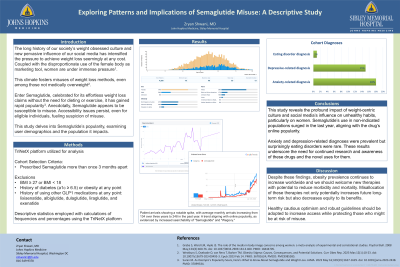Sunday Poster Session
Category: Obesity
P1159 - Exploring Patterns and Implications of Semaglutide Misuse: A Descriptive Study
Sunday, October 22, 2023
3:30 PM - 7:00 PM PT
Location: Exhibit Hall

Has Audio

Zryan ELI Shwani, MD
Johns Hopkins Community Physicians
Washington, DC
Presenting Author(s)
Zryan ELI. Shwani, MD
Johns Hopkins Community Physicians, Washington, DC
Introduction: The pervasive influence of social media and the weight-obsessed media culture in Western society has intensified the pressure to achieve weight loss, fitness, and a slim physique. Women bear the brunt of this pressure, with their bodies serving as promotional tools for a multitude of products from a young age. This societal climate creates opportunities for misuse of weight loss techniques, diets, medications, and procedures among individuals who do not meet the medical criteria for overweight or obesity.
With its impressive claims of weight loss without the need for dieting or exercise, Semaglutide has gained rapid popularity in the West. Even individuals who meet the medical criteria face challenges in accessing the medication due to its increasing scarcity. Anecdotally, Semaglutide appears to be susceptible to misuse. In this descriptive study, our objective was to investigate the demographic characteristics of individuals prescribed this medication and the populations it serves.
Methods: Using the TriNetX platform, we analyzed a cohort of patients who did not meet criteria for Semaglutide prescription: diabetes or obesity (BMI ≥ 30) or overweight with an obesity-related condition (BMI ≥ 27). Exclusions encompassed BMI ≥ 30, BMI < 18, diagnosed diabetes or obesity, and use of other GLP1 medications. Descriptive statistics calculated frequencies and percentages with TriNetX.
Results: Analysis of 4,266 patients revealed a female majority (73% vs. 27% male) among Semaglutide users. The majority were white (69%), with 18% Black or African American, and 3% Asian. The cohort's average age was 53 (range: 18-90). Patient arrivals showed a notable spike since May/June 2022, with average monthly arrivals increasing from 134 over three years to 248 in the past year. This trend aligns with online popularity, as evidenced by increased searchability of "Semaglutide" and "Wegovy." Regarding diagnoses, 18% had anxiety-related diagnoses, 15% had depressive-related diagnoses, and only 1% had eating disorder diagnoses (ICD 10 F50). Regarding cohort diagnoses, 18% of patients had an anxiety-related diagnosis, while 15% had a diagnosis related to depression. Surprisingly, only 1% of the cohort had a diagnosis of eating disorders (ICD 10 F50).
Discussion: This study provides insights into the demographics of Semaglutide use in non-indicated populations. Understanding the characteristics of these individuals is crucial for addressing potential risks associated with Semaglutide misuse and its societal impact.
Disclosures:
Zryan ELI. Shwani, MD. P1159 - Exploring Patterns and Implications of Semaglutide Misuse: A Descriptive Study, ACG 2023 Annual Scientific Meeting Abstracts. Vancouver, BC, Canada: American College of Gastroenterology.
Johns Hopkins Community Physicians, Washington, DC
Introduction: The pervasive influence of social media and the weight-obsessed media culture in Western society has intensified the pressure to achieve weight loss, fitness, and a slim physique. Women bear the brunt of this pressure, with their bodies serving as promotional tools for a multitude of products from a young age. This societal climate creates opportunities for misuse of weight loss techniques, diets, medications, and procedures among individuals who do not meet the medical criteria for overweight or obesity.
With its impressive claims of weight loss without the need for dieting or exercise, Semaglutide has gained rapid popularity in the West. Even individuals who meet the medical criteria face challenges in accessing the medication due to its increasing scarcity. Anecdotally, Semaglutide appears to be susceptible to misuse. In this descriptive study, our objective was to investigate the demographic characteristics of individuals prescribed this medication and the populations it serves.
Methods: Using the TriNetX platform, we analyzed a cohort of patients who did not meet criteria for Semaglutide prescription: diabetes or obesity (BMI ≥ 30) or overweight with an obesity-related condition (BMI ≥ 27). Exclusions encompassed BMI ≥ 30, BMI < 18, diagnosed diabetes or obesity, and use of other GLP1 medications. Descriptive statistics calculated frequencies and percentages with TriNetX.
Results: Analysis of 4,266 patients revealed a female majority (73% vs. 27% male) among Semaglutide users. The majority were white (69%), with 18% Black or African American, and 3% Asian. The cohort's average age was 53 (range: 18-90). Patient arrivals showed a notable spike since May/June 2022, with average monthly arrivals increasing from 134 over three years to 248 in the past year. This trend aligns with online popularity, as evidenced by increased searchability of "Semaglutide" and "Wegovy." Regarding diagnoses, 18% had anxiety-related diagnoses, 15% had depressive-related diagnoses, and only 1% had eating disorder diagnoses (ICD 10 F50). Regarding cohort diagnoses, 18% of patients had an anxiety-related diagnosis, while 15% had a diagnosis related to depression. Surprisingly, only 1% of the cohort had a diagnosis of eating disorders (ICD 10 F50).
Discussion: This study provides insights into the demographics of Semaglutide use in non-indicated populations. Understanding the characteristics of these individuals is crucial for addressing potential risks associated with Semaglutide misuse and its societal impact.
Disclosures:
Zryan Shwani indicated no relevant financial relationships.
Zryan ELI. Shwani, MD. P1159 - Exploring Patterns and Implications of Semaglutide Misuse: A Descriptive Study, ACG 2023 Annual Scientific Meeting Abstracts. Vancouver, BC, Canada: American College of Gastroenterology.
